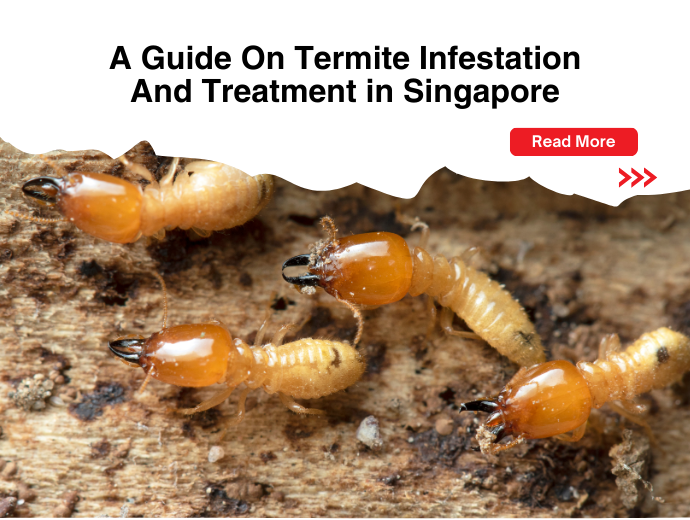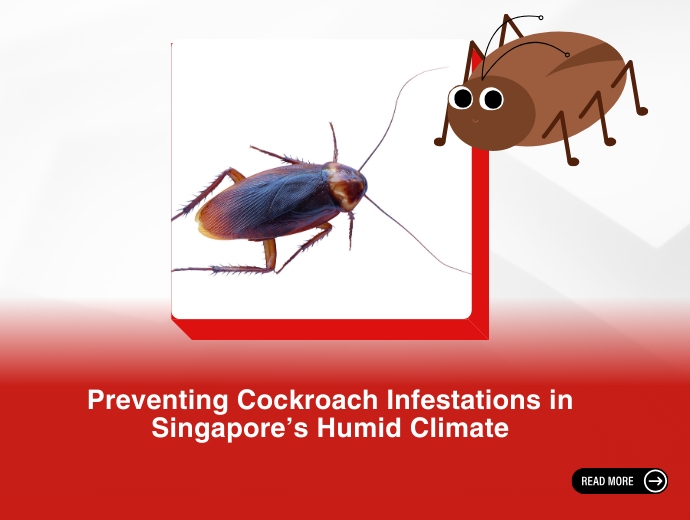Introduction
We bet you never knew that termites evolved from cockroaches! Well, NUS professors have discovered the fascinating transition and shared ancestry of ancient cockroaches to termites, dating back about 170 million years. The evolution of this insect group occurred with their ability to digest cellulose – the most abundant organic molecule on our planet (the main compound found in wood and plant cell walls). Today, termite infestation in Singapore has become a common pest problem, causing significant damage to properties. A report from the BCA highlights that termites can cause up to 15% structural damage to any building!
In this blog, we will delve deeper into the early signs of termite infestation, prevention strategies, and expert termite control measures in Singapore.
Termites Found in Singapore and Why They Are a Problem
Termites, or ‘white ants,’ are tiny insects that thrive on cellulose-based materials, especially timber. Singapore’s warm and humid climate provides an ideal environment for these pests to survive. Our country, therefore, remains infested with two main types of termites: drywood and subterranean termites. The drywood termites feed on dry wood with no contact with mud or soil, while the subterranean termite nests underground and travels to food sources by building mud tubes. Additionally, the third species damp wood, or garden termite dwells in damp, fallen trees, and decaying logs. They can be found in forested areas, rotting timbers, under the soil near trees, or in homes with poor ventilation and water leakages.
Recent studies indicate that 70% of termite infestation in Singapore are caused by subterranean species.
Early Signs of Termite Infestation in Singapore
Mud Tubes
As mentioned, subterranean termites build mud tubes with dirt and debris for shelter as they travel to and from their nest and food source. These pencil-sized tunnels or tubes can be seen in wooden structures and stone or concrete foundations. If you are striving for termite treatment on your property, watch out for these types of tubes:
- Working tube – The tunnel between the nest in soil and wood
- Drop tube – The tube from wood or timber back into the soil
- Exploratory tube – Tubes extending only from the soil
These tunnels or tubes can commonly be found on the exterior or interior walls of your property. They primarily serve as access points to your premises.
Wood Tunnels
Also known as galleries, wood tunnels remain hidden from external view. However, they can be spotted once the infested area or the wood gets broken. Wood tunnels are a sure sign that you need professional termite treatment. Modern high-tech devices allow pest experts to detect wood tunnels and monitor termites even when there are no visible external signs.
Discarded Wings
A primary sign of termite infestation is the sighting of discarded wings from alates or swarmers (a type of flying termite) within your property, particularly on windowsills and floors. When male and female termites leave their nest to mate or to form new colonies, they drop their wings.
While some flying species swarm at night, attracted to bright light sources, others swarm in daylight. Several species, like drywood termites, swarm at specific times of the year, often after rains.
Droppings (Frass)
Frass, or termite droppings, are tiny granular pellets commonly visible at the entry points of their nests. These egg-shaped pellets have six sides and are harder and rougher in texture than the frass of other pests, such as beetle larvae or carpenter ants. They often accumulate around or below the base of infested surfaces, resembling piles of sawdust.
Once you spot frass inside your premises, you should immediately contact expert exterminators for termite control.
Tight-Fitting Doors and Windows
As termites devour timber, their mud-like excrement acts as a seal, trapping moisture and heat. This can cause the timber to swell, making the infested wood more difficult to open or close.
Discolouration and Crumbling Wood
If you notice any part of your floor or wall turning black or brown, there is a high chance that termites have invaded. Additionally, if the wood crumbles or falls apart after a slight touch, termites have likely eaten away at the structure.
Damaged Paint and Blisters
While water damage, such as pipe leaks, can cause blistering and paint damage, it may also indicate termite infestation! Termites create moisture that seeps between the paint and the surface, causing damage to drywall.
Hollow Wood and ‘Head Banging’ Sounds
As termites eat the wood from the inside out, an infested area will produce a hollow sound when knocked or tapped.
Another common sound is the quiet clicking or chewing noises coming from walls or furniture. When the colony is disturbed, soldier termites shake their bodies and bang their heads against the wood to signal danger. If you listen closely by placing your ear near the suspected infested surface, you may hear these unusual sounds.
Preventive Termite Treatment Measures
Termite-proof the foundation: Minimise wood in the foundation of your home instead use concrete. In Singapore, it might be difficult to eliminate wood entirely from the foundation! You can, therefore, apply a sealant to the timber to avoid future termite infestation. Additionally, ensure a minimum 18-inch distance between the soil and the wood.
Stop leakages: Termites attack poorly maintained properties with abundant moisture, cracks, gaps, and crevices. Therefore, focus on the overall maintenance of your house and fix all leaks and cracks that invite moisture and mould.
Pre-treat your home: Before priming or painting the wooden furniture or other materials, spray them with borate. This is one of the most effective and commonly used termite repellents. Similarly, several eco-friendly liquid termiticides can create a barrier to block wandering termites from entering the house premises. These chemicals also kill the termites and keep them from breeding.
Mind those cardboard boxes and woodpiles: Cardboards and wood piles can become a termite haven if left uncleaned and unchecked! Store these items far away from your home in termite-free storage.
Opt for regular termite inspection: Prevention is better than…! Well, yes, while the above measures will keep the insects away, the best termite treatment strategy is to have your property inspected by professional exterminators. Get your home comprehensively scanned at least once a year to stay stress-free.
Expert Termite Treatment Techniques
Thermal Imaging
This is a science-based approach that helps in identifying termite infestation that helps prepare a solution programme to control termites.
ORIGIN’s Termite Specialist inspects the infested area using a Thermal Imaging Camera. All water leakage areas and surfaces like false ceilings, door frames, and wooden skirtings are thoroughly checked. The report of Thermal Imaging Inspection will highlight all the zones that vary in temperature or show thermal abnormality (even with 0.1 degrees Celsius). It is these areas that can be (or are) infested!
Termite Baiting
Baiting is one of the most preferred termite treatment as it helps combat the underground subterranean termite colony. Baiting stations containing termite-attracting materials like cellulose are placed either above-ground or in-ground. The bait stations contain an insect growth regulator (IGR), which acts like a slow poison for these pests and disrupts their moulting process. The worker termites feed on them and carry the bait back to their colonies, where the regulator spreads, thereby eliminating the entire colony gradually in 3 to 6 months.
Soil Drenching
Subterranean species thrive in the soil beneath plants and trees. With the soil drenching technique, termite control becomes easy and saves trees from damage. In this method, a trench is dug around the tree to allow termicide to seep into the soil, thereby killing their colonies.
Foam Insecticide treatment
For dry wood termite control, foam Insecticide treatment is crucial. A special termiticide foam is injected into the areas where the pests are active such as small holes in the wood, wall cracks, or along blisters. The foam penetrates deep into the cracks and voids, leaving a residue that eliminates termites upon contact.
Dusting
This is a pocket-friendly and the most conventional method of termite treatment. In this method, the insecticidal dust is puffed in the mud tube. The puffed foraging termites carry and pass the toxic dust to their nestmates which eliminates their entire colony.
Conclusion
By identifying the early signs, you can detect termite infestation in your home or property. If you can carry out preventive termite control measures effectively, you will succeed in overcoming major structural damage. However, if you encounter a serious influx, we recommend seeking professional termite treatment immediately. Specialists from ORIGIN Exterminators can efficiently remove these pests.
To request a termite inspection or treatment, contact us at 62805666 or WA: 90077134.
We will quickly address your queries and concerns.
Check out blog on Why Regular Maintainence is necessary after termite treatment here!




.png)
